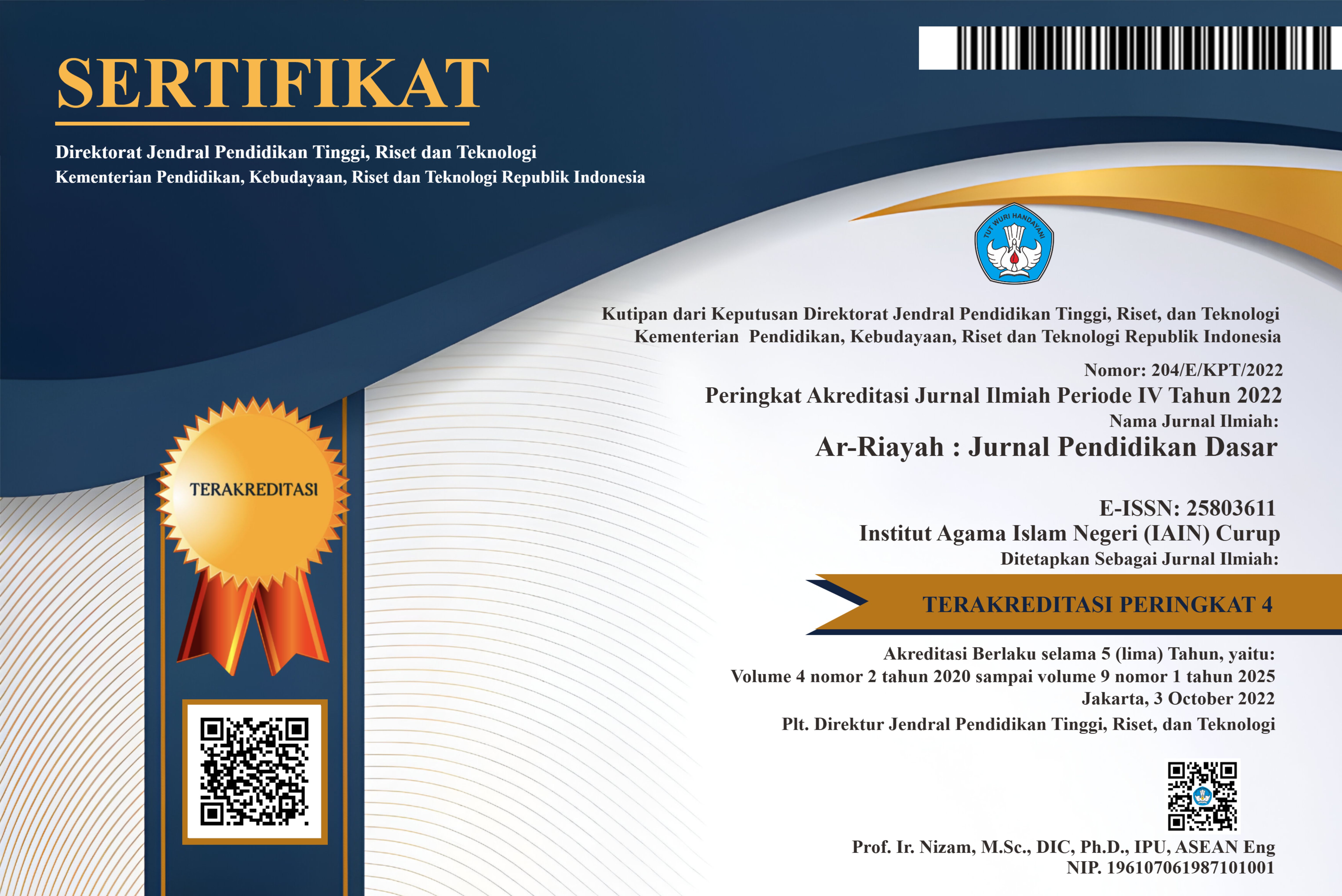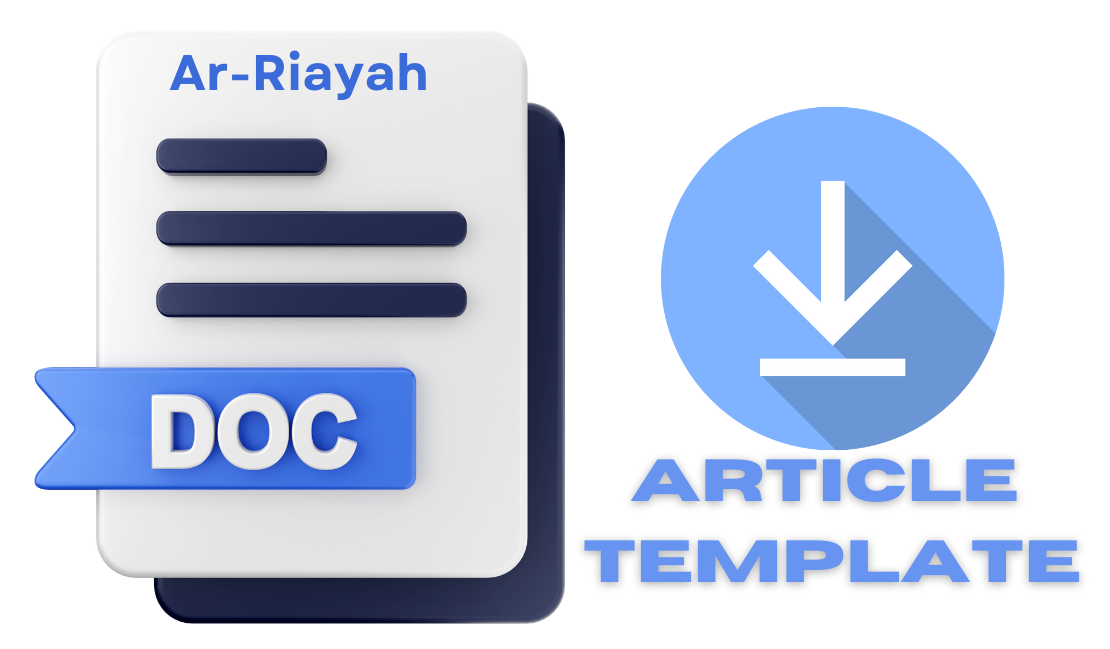Pengaruh Model Pembelajaran Take And Give Berbantuan Media Audio Visual Terhadap Hasil Belajar Kelas III
DOI:
https://doi.org/10.29240/jpd.v6i2.5516Keywords:
Model Pembelajaran, Take and Give, Audio Visual, Hasil BelajarAbstract
The learning process carried out by educators is varied in using learning models, but student learning outcomes are still low. Based on these problems, the researchers tested the learning process using a learning model that educators had never used, namely the take and give model. This study aims to determine the effect of the take and give learning model assisted by audio-visual media on learning outcomes for class III MIN 10 Bandar Lampung. The type of research used is quantitative research, with a quasi-experimental design (nonequivalent control group design). The place where this research was carried out was at MIN 10 Bandar Lampung. This research was conducted in class III, using two classes as the experimental class and the control class and one class as the validation class. The instruments used to collect data in this study were tests, interviews, and documentation. Data analysis technique using t-test. The results showed that there was an effect of using the take and give learning model assisted by audio-visual media on the learning outcomes of class III MIN 10 Bandar Lampung
Downloads
References
A Octavia, Shilphy. Model-Model Pembelajaran. yogyakarta: deepublish, 2020.
Al-Falah, Maxima Rino, Ali Imron, and Muhammad Basri. “Penerapan Model Pembelajaran Take and Give Untuk Meningkatkan Motivasi Belajar Siswa Kelas VIII.†Jurnal FKIP UNILA 01, no. 01 (2020): 1–12.
Asmawati, Rahayu. “Pengaruh Model Pembelajaran Take And Give Terhadap Kemampuan Menulis Berita Siswa Kelas Viii Smpn 13 Kota Sukabumi.†Skripsi Universitas Muhammadiyah Sukabumi., 2018.
Fadjarajani, Siti, Ely Satiyasih Rosali, and Widyanti Noerdianasari. “Pengaruh Model Pembelajaran Picture And Picture Terhadap Hasil Belajar Geografi.†Perspektif Ilmu Pendidikan 34, no. 1 (April 29, 2020): 19–28. https://doi.org/doi.org/10.21009/PIP.341.3.
Hardani, Nur Hikmatul Auliy, Helmina Andriani, Roushandy Asri Fardani, Jumari Ustiawaty, Evi Fatmi Utami, Dhika Juliana Sukmana, and Ria Rahmatul Istiqomah. Buku Metode Penelitian Kualitatif Dan Kuantitatif. Yogyakarta: Pustaka Ilmu Group, 2020.
Hermawan, Hary. “Metodologi Riset Kuantitatif: Riset Bidang Kepariwisataan.†Open Sciene Framework, no. August (2020): 16. https://doi.org/10.17605/OSF.IO/YBSW9.
Ifrianti, Syofnidah. Teori Dan Praktek Microteaching. yogyakarta: pustaka pranala, 2021.
Jufrida, Jufrida, Fibrika Rahmat Basuki, Miko Danu Pangestu, and Nugroho Asmara Djati Prasetya. “Analisis Faktor Yang Mempengaruhi Hasil Belajar Ipa Dan Literasi Sains Di Smp Negeri 1 Muaro Jambi.†EduFisika 4, no. 02 (2019): 31–38. https://doi.org/10.22437/edufisika.v4i02.6188.
Juliarta, I Wayan Agus, Made Putra, and I Gusti Agung Oka Negara. “Pengaruh Model Pembelajaran Take and Give Berbantuan Media Question Card Terhadap Kompetensi Pengetahuan Ppkn.†Jurnal Penelitian Dan Pengembangan Pendidikan 4, no. 2 (2020): 166. https://doi.org/10.23887/jppp.v4i2.27361.
Kaharuddin, Andi, and Nining Hajeniati. Pembelajaran Inovatif & Variatif Pedoman Untuk Penelitian PTK Dan Eksperimen. sulawesi selatan: pusaka almaida, 2020.
Luritawaty, Irena Puji. “Pengembangan Kemampuan Komunikasi Matematik Melalui Pembelajaran Take and Give.†Mosharafa: Jurnal Pendidikan Matematika 8, no. 2 (2019): 239–48. https://doi.org/10.31980/mosharafa.v8i2.378.
Mandagi, Mieke, roeth ao Najoan, rd nia kania Kurniawati, Enih Rosamah, Andoyo Supriyantono, Zuyasna, Rita Ismawati, Muhammad Zaenuddin, and etik puji Handayani. Inovasi Pembelajaran Di Pendidikan Tinggi. yogyakarta: deepublish, 2020.
Marlina et al; “Pengembangan Media Pembelajaran SDMI.†Aceh: Yayasan Penerbit Muhammad Zaini, 2021.
Safitri, Mega Buana. “Pengaruh Model Pembelajaran Take And Give Terhadap Keterampilan Menulis Teks Prosedur Pada Siswa Kelas Xi Sma Negeri 1 Rasau Jaya.†Skripsi Ikip Pgri Pontianak., 2020.
Sanjaya, Wina. Strategi Pembelajaran Berorientasi Standar Proses Pendidikan. jakarta: kencana, 2018.
Shoffa, Shoffan, Iis Holisin, Josua F. Palandi, Sri Cacik, Dian Indriyani, Eko Eddya Supriyanto, Abdul Basith, and Yo Ceng Gia. Perkembangan Media Pembelajaran Di Perguruan Tinggi. Jawa Timur: anggrapana media, 2021.
Silkyanti, Fella. “Analisis Peran Budaya Sekolah Yang Religius Dalam Pembentukan Karakter Siswa.†Indonesian Values and Character Education Journal 2, no. 1 (2019): 36. https://doi.org/10.23887/ivcej.v2i1.17941.
Sugiyono. Metode Penelitian Kuantitatif Kualitatif Dan R&D. bandung: alfabeta, 2019.
Sulfemi, Wahyu Bagja, and Hilga Minati. “Meningkatkan Hasil Belajar Peserta Didik Kelas 3 Sd Menggunakan Model Picture and Picture Dan Media Gambar Seri.†Jurnal Pendidikan Sekolah Dasar 4, no. 2 (2018): 228. https://doi.org/10.30870/jpsd.v4i2.3857.
Sunardi. Kepala Sekolah Perisai Peserta Didik. jakarta selatan: rumah media, 2020.
Theriana, Ana. “Pengaruh Model Pembelajaran Take and Give Terhadap Hasil Belajar Siswa Pada Mata Pelajaran Bahasa Inggris Di SD IT Qurrota’ayun Belitang OKU Timur.†Scholastica Journal 2, no. 1 (2019): 90–170.
Ulya, H, N. H Laily, and M. L Hakim. “Pengembangan Media Pembelajaran PAI Dengan Menggunakan Video Explanasi, Pop Up Dan Kahoot.†Edudeena: Journal of Islamic Religious Education, 4, no. 1 (2020): 39–48.
Downloads
Additional Files
Published
How to Cite
Issue
Section
Citation Check
License
Authors who publish with Ar-Riayah: Jurnal Pendidikan Dasar agree to the following terms:
Authors retain copyright and grant the journal right of first publication with the work simultaneously licensed under a Creative Commons Attribution-NonCommercial-ShareAlike 4.0 International License (CC BY-NC-SA 4.0) that allows others to share the work with an acknowledgment of the work's authorship and initial publication in this journal.
Authors are able to enter into separate, additional contractual arrangements for the non-exclusive distribution of the journal's published version of the work (e.g., post it to an institutional repository or publish it in a book), with an acknowledgment of its initial publication in this journal.
- Authors are permitted and encouraged to post their work online (e.g., in institutional repositories or on their website) prior to and during the submission process, as it can lead to productive exchanges, as well as earlier and greater citation of published work (See The Effect of Open Access).










